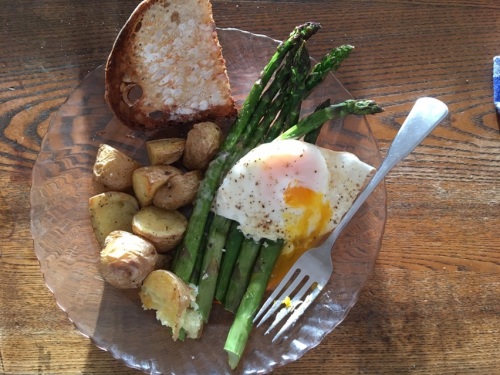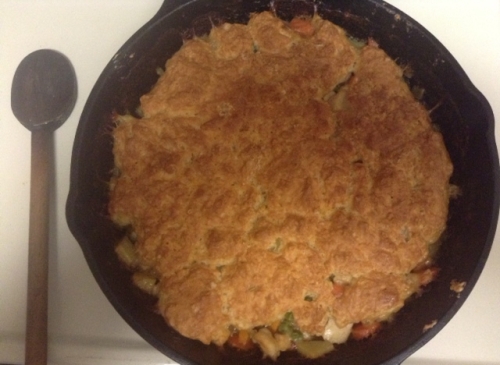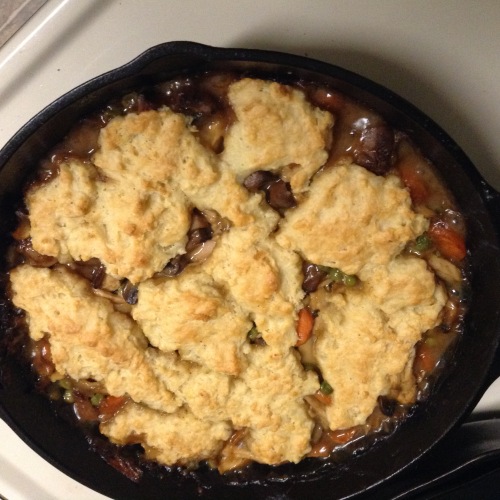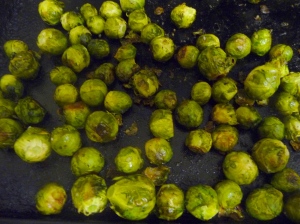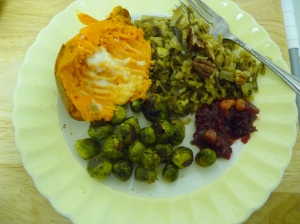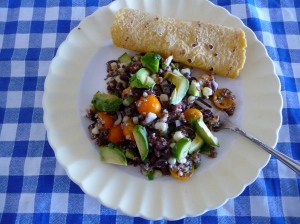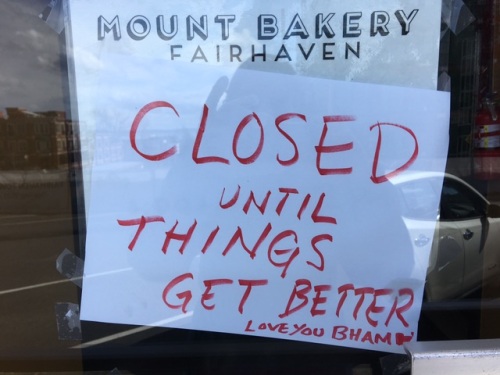
THE WORLD HAS CHANGED PROFOUNDLY since I wrote the last post in January with advice from an Italian grandmother about cooking vegetables. Here in Washington state–where restaurants and coffee shops and even some bakeries have been closed for several weeks–the pandemic has also affected our kitchens, our cupboards and many of our habits surrounding food.
Before I say anything about that, though, I must say that my thoughts and worries are with all the people suffering and dying from the virus and with all those who care for them, at their own risks. I’ve been obsessively reading stories from the four online news sources that we subscribe to, as well as the stories that my friends send me, and frankly, it’s been hard to concentrate on writing a post or much of anything else recently.
Plus I’ve been wondering — in such disturbing times, is it too shallow and irrelevant to write about food?
And yet, food is essential, as we know, and our practices and habits around food can contribute to our physical and emotional health — or just the opposite. But you’ve probably read enough elsewhere of food advice and pantry recipes, so I decided to simply write a personal account of my experiences and thoughts about food in these recent weeks of the coronavirus.
Steve and I are both old enough (70+) to be in the extra-cautious category, and suddenly, as the Covid-19 reality set in, we realized that we could not continue to go to the grocery store whenever we wanted or even be able to find everything we wanted when we did go. We had been in Southern California when the virus first hit the U.S., and our home state of Washington. We returned home to Washington on March 8 — before the governor closed all schools in the state and banned large gatherings.
But as we drove home, listening to the frightening news on NPR, we decided we had to change our ingrained habits. No more going out to restaurants or coffee shops. No casual trips to the grocery store. There’s a perfectly fine grocery store just half a mile from my house, and I often walk there (or I used to do so) several times a week to pick up this or that. No more of that. Every shopping trip now had to be considered a possible exposure to Covid-19.
Before we sequestered ourselves, and switched to mainly grocery delivery, we allowed ourselves one time — the day after we returned home — to stock up on what we thought we’d need for two or three weeks to come. I worried that by now some of the grocery shelves would be empty. In the days before our “Big Shop” sometimes I was unable to sleep until I’d written down one more item on a Post-it or yellow legal pad or back of an envelope. This was crazy.
At our neighborhood grocery and Trader Joe’s we loaded our cart with basics like olive oil and bags of flour, walnuts, rice and beans, lentils, pasta, milk and cheese and butter. We tossed in canned tomatoes, mini-ravioli, frozen corn, raspberries and blueberries. Fresh fruit that could keep awhile, mainly oranges and mandarins, but also a pineapple. Onions, garlic, carrots, potatoes and sweet potatoes. Fresh green vegetables (broccoli, green beans) that I could parboil right after I got home, as I wrote about in the last post. And condiments: olives, roasted red peppers, salsa and artichoke hearts. Treats of course: a few bags of organic corn chips, some chocolate bars, a bottle of wine…

The pasta supply was nearly emptied (forget about toilet paper and hand sanitizer!) Now even dried beans and flour are almost impossible to find.
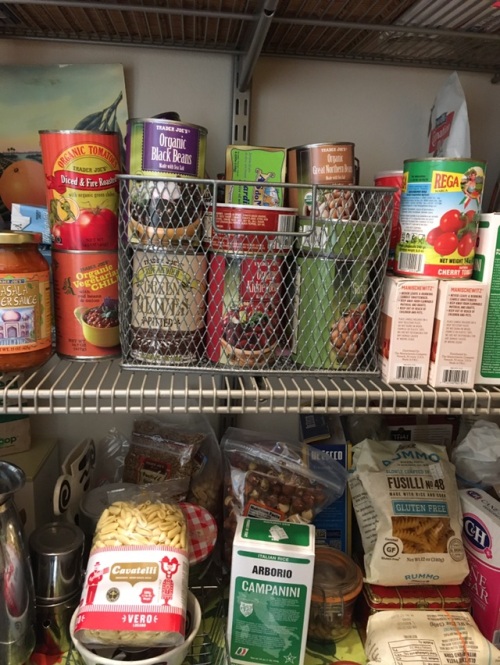
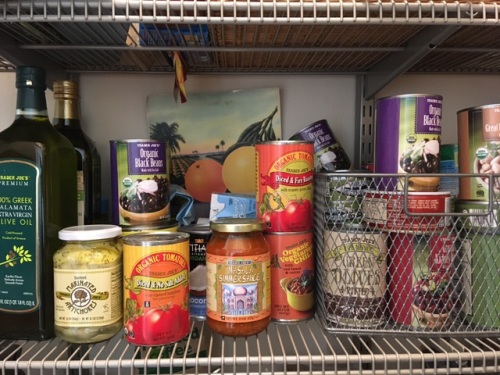
We filled the shelves and some of the floor space in our closet-sized pantry, packed the refrigerator and freezer (oh, for a stand-alone freezer!). I had stocked, but not stockpiled or overstocked. This wasn’t a survivalist’s year-long supply, but rather enough food for about two weeks, and all of it food that we regularly ate.
LATER, especially as the fresh vegetables dwindled, I was especially glad that I’d remembered to get some of the all-important condiments. A jar of roasted red peppers could stay in the cupboard until needed; then, chopped or sliced, those red peppers could brighten up a dish or add interest to a grilled cheese sandwich (I’d almost forgotten how good a grilled cheese sandwich could be!). Olives, marinated or canned artichoke hearts, pickles and pickled vegetables, a chunk of Parmigiano Reggiano, capers — these condiments, along with herbs and spices and perhaps a few jars of sauces, added so much to the staples, especially when fresh vegetables were running low.
Still — the staples are vital, and for me the top of the list is bread. I felt especially ready for this aspect of food preparation since I’ve been baking bread for most of my life.

BAKING BREAD, it turned out, was one of the few activities I could concentrate on in this anxious and disturbing time. My son (an incredibly dedicated home baker) had given me some lively sourdough starter he’d made years before, and I was literally keeping it alive by feeding and replenishing it. From the time I’d feed the starter for the batch of dough–which I stretched and folded, shaped into a loaf and proofed overnight–to when I pulled the fragrant loaf out of the oven some 36 to 48 hours later, the whole process gave me a deep satisfaction, a connection to the good fundamentals of life.
But then I discovered something which stopped me cold: Flour— any kind of regular wheat flour (all-purpose, bread flour, whole wheat flour) — was disappearing from the shelves! My daughter, also an avid and wonderful home baker, told me she could not find it in several stores in Fayetteville, Arkansas. I checked sites online — King Arthur, Amazon, Fred Meyer, Safeway: NO wheat flour.
I texted my son in Berkeley. He’d recently recovered from a frightening experience with Covid-19 symptoms. We transmitted flour-deprivation anxiety and suggestions through email and text. My son suggested that I could try to buy some from a bakery or a restaurant supply store (he regularly buys 50-pound bags of flour from such a store). My daughter, who has her own grain mill, decided to order a 25-pound bag of white winter wheat berries from Palouse Brand.
If I was really up against it, my son said, he could send me five pounds of flour through the mail.
I was not at that point — and to be honest, I still had enough to last me a couple weeks, especially with Passover (no flour use) around the corner. But I suddenly understood (and resented) panic buying. I realized a lot of people were using the time at home to experiment with baking or for “baking-therapy” …. but come on: Could they be really be using that much flour to leave the shelves bare?? I had a sneaking suspicion that there was a lot of stockpiling going on. And for the first time, I too felt suddenly panicked, about food.

THEN SOMETHING WONDERFUL and unexpected happened. A friend and neighbor who had heard about my flour-worries left a nearly full bag of King Arthur bread flour at my doorstep. This act of kindness made me so happy and immediately calmed my anxiety.
As I made my next loaf of bread, I thought of the ways that our friends and family and neighbors were watching out for each other. My son was willing to mail flour to me; my neighbor contributed her supply to calm my nerves. I was bringing minestrone soup and cinnamon rolls to my terrific 90-year old neighbor, and she had bought a rice cooker for me so that we could all share in freshly cooked nutritious brown rice. My family and friends kept up a conversation about what we were eating and sent photos of our latest creations to each other on e-mail. And with an increasing awareness that so many people now are in need of food, we were inspired to donate to food banks and hunger relief organizations like Northwest Harvest.
Of course food is essential to nourish and sustain our physical and emotional health, but it can also bridge the isolation of social distancing, helping us to nourish and sustain our relationships. And that, too, is essential.





